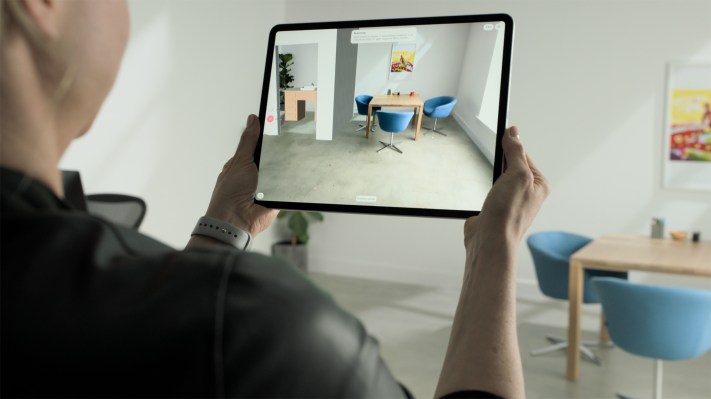Augmented reality still has Apple’s enthusiasm behind it, but can that keep the whole industry afloat?
On Wednesday, Apple debuted a new iPad Pro, the hallmark feature of which was a lidar time-of-flight sensor baked into the camera, which is designed to make augmented reality experiences more realistic and immersive. For most potential users, the inclusion is something of an oddity. Consumer AR apps are few and far between, and Apple has also been slow to bring AR functionality into its own stock apps.
For the AR industry, the hardware inclusion amounts to an industry gift, signaling once again that Apple is still committed to making an augmented reality future happen.
The company’s ARKit development platform has brought out some interesting use cases, but app developers have scored few resounding victories. The reasons why increasingly seem to have little to do with individual technical features of the development platform or camera hardware. Apple can keep improving both, but without some concerted integrations of AR functionality into the core of iOS or iPadOS, it’s unclear whether these little developer-focused feature bumps will make a dent. Consumers just don’t see anything they want yet.
AR startups have already been struggling and hardware efforts have largely cratered. The software platforms have had some success building what Apple hasn’t or won’t for niche enterprise customers, but as the economic realities shift, all bets are off.
Recession-grade uncertainty isn’t great for moonshots. In general, during a recession frontier tech startups are likely in for a rougher time than more established business categories and AR startups can be particularly at risk with enterprises looking to cut back discretionary spending and nary a strong consumer platform to be seen.
When times turn tough, there’s the temptation to appoint a savior. For the entirety of 2016 and 2017, AR startups spoke about Magic Leap as if its platform would prove out the space and build out a network of users that could soon be tapped into. Magic Leap and its hardware have fallen far short of expectations and many of the startups that once pinned their hopes on its success have since shuttered.
Magic Leap’s position as a deep-pocketed conductor for the AR industry has now been fully shifted to Apple, where it has now resided for years, with founders loudly proclaiming that Apple’s attention here not only signals the worth of the space but will also soon mean a consumer boom once the company opts to release its long-awaited AR glasses.
Just as before, there is the risk that Apple won’t meet expectations or build a platform that’s as friendly to third parties initially. Apple seems like a wildly less-risky bet on which to place one’s hopes, but the company has delivered flops before or — more often — devices that only came into their own after several iterations. A lengthy onramp to consumer adoption would obviously mean trouble for existing startups.
The biggest warning sign here is that Apple isn’t waiting to enter the AR space, as it has been treating augmented reality as a headliner at its events for years now.
As Apple makes additional featured upgrades to its software and hardware year after year, it seems to be growing clearer that it very well might not find success on tablet or phone-based AR in any capacity until a glasses launch proves out a wider platform. As a result, updates like today’s iPad Pro refresh seem as though they’ll have precious little effect on an industry that has become obsessed with placing its hopes and dreams on widespread adoption of the next, next thing.
Apple is rumored to be devoting massive resources to its AR dreams, but even for the consumer tech giant, the technology still looks like a massive gamble.
